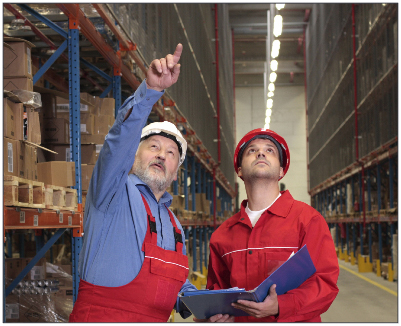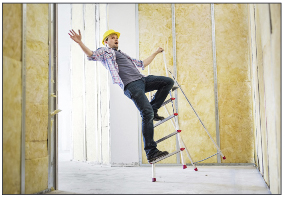 Always Investigate the Accident
Always Investigate the Accident
What is an Accident?
An accident is an unplanned occurrence that interferes with the orderly process of work resulting in an interruption of service, reduced production, property damage, personal injury or death.
Why Do Accidents Happen?
An accident can result from an unsafe action by a person, an unsafe physical condition, or a combination of both. There are often multiple contributing factors involved in an accident—most of which can be controlled. Unless a thorough investigation proves otherwise, you should assume that an accident can be prevented.
Why Investigate An Accident?
Accident investigation is the method of examining the facts surrounding an incident and identifying the contributing factors, unsafe behavior, and/ or unsafe conditions that led to the accident. Once contributing factors are identified, steps can be taken to eliminate a hazard or changes a function to prevent similar accidents.
The root cause, or the underlying reason for the accident, is often a “system failure”. Discovering a systems failure and correcting it is an important way for management to improve work practices and / or working conditions.
Contributing Accident Factors
Human Behaviors:
Personal Beliefs or Feelings
- Did not believe an accident would occur to him / her.
- Did not follow rules because he / she disliked rules and authority.
- Worked unsafely because of peer pressure.
- Enjoyed working fast, showing off, being “macho” or “knowing it all”.
System Failure
A “system failure” is an error, mistake, or lapse in management control (not grossly negligent or “serious and willful” in nature) that allows or contributes to an accident.
Examples:
- System failure.
- Lack of clear policy, rules or procedures.
- Failure in hiring or placement procedures.
- Inadequate employee training.
- Lack of in-depth accident investigations that identify cause of accidents.
- Industrial health exposures not recognized or controlled.
- Rules not enforced.
- Safe behavior not reinforced.
- Necessary equipment or materials not provided.
- Production requirements too high.
- Poor safety communications (safety is not adequately publicized or promoted)
- Poor safety organization (authority, goals, responsibility, and accountability lacking).
- Inadequate knowledge and analysis of jobs and potential hazards.
- Lack of full management and supervisory support for the safety program.
Deliberate or Unintentional Actions
Most people choose positive behaviors that bring a reward—self-pride, management praise, or peer approval.
Others may choose negative/unsafe behaviors as a way to gain personal power, retaliate against management, or attract attention, such as:
- Made a conscious or unconscious decision to work unsafely.
- Did not remember or follow safety rules or recommended procedures.
- Engaged in horseplay or fighting.
- Used drugs or alcohol.
- Used incorrect equipment.
- Chose improper work methods.
- Used improper body mechanics.
- Did not ask for equipment, information, or assistance needed to do job safely.
- Make a mistake, was forgetful, lost focus, or was distracted.
- Used poor judgement or planning.
Lacked physical and/or mental capacity such that he or she was not able to safely perform the task. Examples include:
- Physical condition or health issues.
- Fatigue or excessive stress.
- Mentally unfocused or distracted.
- Task too complex or difficult.
- Environmental excesses, such as noise, dust, heat, etc.
- Substance abuse.
- Improper ergonomic interaction between the person and the task.
Physical Conditions:
Environment, Equipment, Facility
- Inadequate inspections and / or corrections of hazard.
- An unsafe physical condition may be constant or unplanned and random.
- Defective equipment, tools, machines, or facilities.
- Missing safety equipment.
- Poor housekeeping.
- Uncomfortable temperatures.
- Extreme or unexpected weather conditions.
 Traps
Traps
A trap is an unsafe condition created by poor workstation or job design that is likely to produce an unsafe action thus increased the probability of an accident.
- Personal protective equipment not provided or replaced.
- Confusing displays or controls.
- Poor adjustability, layout, or size of the work area.
- Inadequate mechanical lifting equipment.
- Uncontrolled slip / fall hazards.
- Excessive reaching, bending, stooping, twisting, contact pressure, vibration, repetition, or force.
- Awkward postures or movement as the result of poor tool or workstation design.
- Excessive heat, cold, or noise.
- Insufficient lighting or ventilation.
How to Conduct an Investigation
The primary focus of an accident investigation should be fact finding, and not fault finding. A reliable investigation requires accurate and unbiased reporting.
- Immediately secure the incident site to assure accurate documentation collection. Use photographs, videos, drawings, and measurements.
- Attempt to re-enact the events that led up to the incident.
- Document all aspects of the investigation in writing. Detail factual descriptions of what occurred, not interpretations of facts.
- Inform individuals why they are being interviewed. Ask the same questions of each person interviewed, make sure to perform interviews separately and confidentially.
- Once the investigation is concluded, communicate recommendations and commit to corrective action.
- Notify OSHA / Cal-OSHA as required by law.
- Notify your worker’s compensation insurance carrier if appropriate.
Interviewing Tips
- Put witnesses at ease. Explain that you are trying to find out how the accident occurred so that similar accidents can be prevented.
- Obtain the names, addresses, job titles, and phone numbers of all witnesses.
- Establish where witnesses were at the time of the accident. Were they positioned so that they could see or hear what they saw or heard?
- Determine what they actually saw. Many witnesses will “fill-in” details that they did not actually see after discussing the accident with other witnesses or through their own speculation.
- Identify what is fact and what is the theory in the report.
- Establish potential biases on the part of the witness, (e.g., witness is a good friend or enemy of the injured).
- Ask open-ended questions. Do not reveal information in the questioning process.
- Eliminate the atmosphere of intimidation or fear that may prevent a witness from frankly discussing the accident.
Characteristics of a Reliable Investigator
- The investigator must be objective, knowledgeable, and thorough.
- The investigator must be willing to identify any “systemsfailures” and any of his/her own responsibility for the occurrence of the accident.
- Someone in higher management, who is knowledgeable in safety and accident investigations, must carefully review the investigation. If the investigation is not adequate, further investigation must be done.
- Document the positive. Do not document only the things that went wrong. Include the positive actions that were taken by management to avoid the accident. This documentation maybe come important later, if the accident analysis becomes public.
- Find a solution. An accident analysis should always suggest a practical solution to help prevent the reoccurrence of a similar accident in the future. If no solution is proposed, the analysis is not complete. The solution should also be implemented within a reasonable time frame.
- Stick to facts and logic. An accident analysis should not include exaggerations, base less speculations, logical inconsistencies, or anything that goes beyond the facts or a reasonable analysis of the circumstances.
 Confidentiality
Confidentiality
Accident investigations should be a confidential management report. Investigations should also be confidential because sensitive information in the report could be misinterpreted or used to suggest that the employer has legal liability beyond the normal workers’ compensation benefits.
While confidentiality is important, it does not mean that appropriate parts of an in-depth analysis cannot be shared with select employees or groups of employees.
If the 301 form incident report is required by Cal/OSHA record keeping regulations and an employee asks to see a report concerning their injury, he or she must be given a copy of the 301 report by the end of the next business day.
Complete Necessary Paperwork
Know what necessary paperwork should be completed and by whom. Reporting requirements may differ depending on the type of business and/or established company policy. Complete reports thoroughly, correctly, and submit them in a timely manner.
If an employee has a “serious injury”, it must be reported to Cal/OSHA within eight hours after the employer knows that it has occurred. A serious injury is any injury that involves one or more of the following conditions: hospitalization which lasts more than 24 hours (other than for medical observation), amputation, or disfigurement.
All injuries requiring more than first aid should be reported to your workers’ compensation carrier.
Conclusion
An effective accident investigation program is one of the most important elements of an Injury and Illness Prevention Program. A thorough accident investigation typically reveals information that can be used to prevent future accidents and safeguard individuals.
